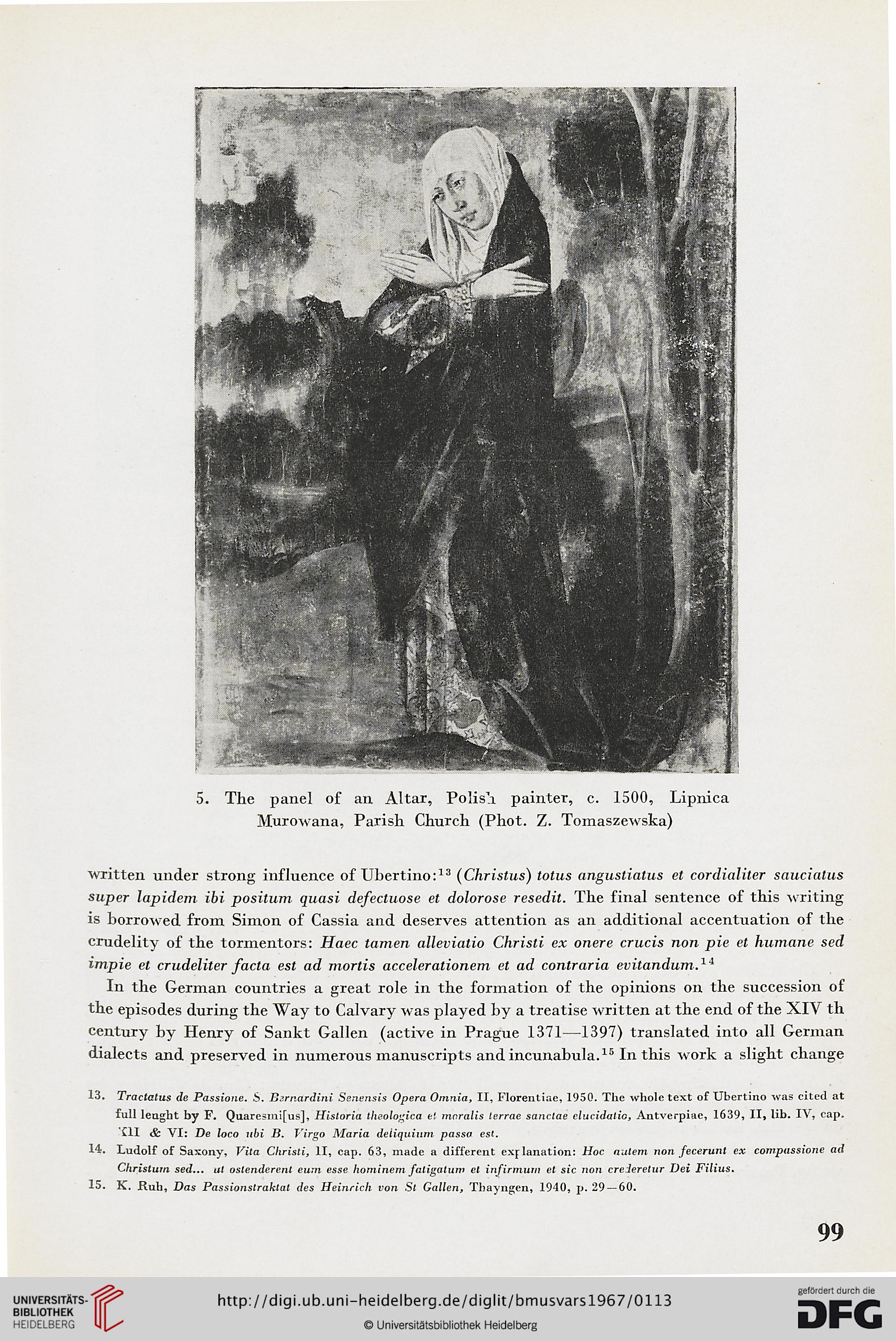5. The panel of an Altar, Polisi painter, c. 1500, Lipnica
Murowana, Parish Church (Phot. Z. Tomaszewska)
written under strong influence of Ubertino:13 (Christus) lotus angustiatus et cordialiler sauciatus
super lapidem ibi positum quasi defectuose et dolorose resedit. The finał sentence of this writing
is borrowed from Simon of Cassia and deserves attention as an additional accentuation of the
crudelity of the tormentors: Haec tamen alleviatio Chrisli ex onere crucis non pie et humane sed
impie et crudeliter facta esl ad morlis accelerationem et ad contr aria evitandum.14
In the German countries a great role in the formation of the opinions on the succession of
the episodes during the Way to Calvary was played by a treatise written at the end of the XIV th
century by Henry of Sankt Gallen (active in Prague 1371—1397) translated into all German
dialects and preserved in numerous mamiscripts and incunabula.15 In this work a slight change
13. Tractatus de Passione. S. Barndrdini Scnensis Opera Omnia, II, Florentiae, 1950. The whole tcxt of Ubertino was cited at
fuli leught by F. Quare5ini[us], Historia theologica et maralis lerrae sanctae elucidalic, Antverpiae, 1639, II, lib. IV, cap.
'CII & VI: De loco ubi B. Virgo Maria deliąuium panna esl.
14. Ludolf of Saxony, Vila Chrisli, II, cap. 63, made a different exrlanation: Hoc autem non fecerunl ex compassione ad
Christurn sed.., at oslenderent eum esse kominem falieatum et infirmum et sic non crederetur Dei Filius.
15. K. Rub, Das Passionstraktat des Heinrich von St Gallen, Tbayngen, 1940, p. 29 — 60.
99
Murowana, Parish Church (Phot. Z. Tomaszewska)
written under strong influence of Ubertino:13 (Christus) lotus angustiatus et cordialiler sauciatus
super lapidem ibi positum quasi defectuose et dolorose resedit. The finał sentence of this writing
is borrowed from Simon of Cassia and deserves attention as an additional accentuation of the
crudelity of the tormentors: Haec tamen alleviatio Chrisli ex onere crucis non pie et humane sed
impie et crudeliter facta esl ad morlis accelerationem et ad contr aria evitandum.14
In the German countries a great role in the formation of the opinions on the succession of
the episodes during the Way to Calvary was played by a treatise written at the end of the XIV th
century by Henry of Sankt Gallen (active in Prague 1371—1397) translated into all German
dialects and preserved in numerous mamiscripts and incunabula.15 In this work a slight change
13. Tractatus de Passione. S. Barndrdini Scnensis Opera Omnia, II, Florentiae, 1950. The whole tcxt of Ubertino was cited at
fuli leught by F. Quare5ini[us], Historia theologica et maralis lerrae sanctae elucidalic, Antverpiae, 1639, II, lib. IV, cap.
'CII & VI: De loco ubi B. Virgo Maria deliąuium panna esl.
14. Ludolf of Saxony, Vila Chrisli, II, cap. 63, made a different exrlanation: Hoc autem non fecerunl ex compassione ad
Christurn sed.., at oslenderent eum esse kominem falieatum et infirmum et sic non crederetur Dei Filius.
15. K. Rub, Das Passionstraktat des Heinrich von St Gallen, Tbayngen, 1940, p. 29 — 60.
99




